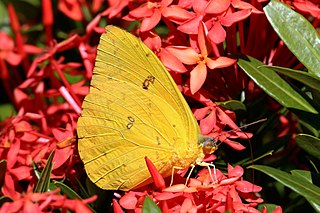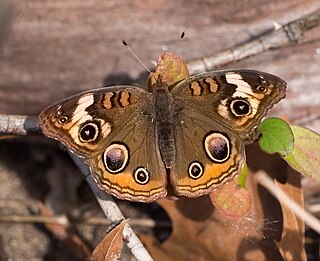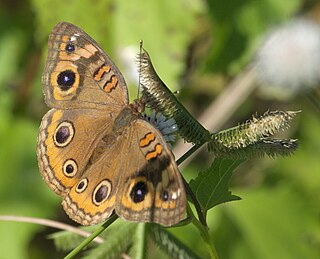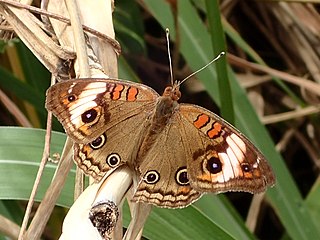
Phoebis sennae, the cloudless sulphur, is a mid-sized butterfly in the family Pieridae found in the Americas. There are several similar species such as the yellow angled-sulphur, which has angled wings, statira sulphur, and other sulphurs, which are much smaller. The species name comes from the genus Senna to which many of the larval host plants belong.

Junonia coenia, known as the common buckeye or buckeye, is a butterfly in the family Nymphalidae. Its range covers much of North America and some of Central America, including most of the eastern half of the US, the lower to middle Midwest, the Southwest, southern Canada, and Mexico. Its habitat is open areas with low vegetation and some bare ground. Its original ancestry has been traced to Africa, which then experiences divergence in Asia. The species Junonia grisea, the gray buckeye, is found west of the Rocky Mountains and was formerly a subspecies of Junonia coenia.

Junonia is a genus of nymphalid butterflies, described by Jacob Hübner in 1819. They are commonly known as buckeyes, pansies or commodores. This genus flies on every continent except Antarctica and Europe. The genus contains roughly 30 to 35 species.

Leptotes is a butterfly genus in the family Lycaenidae. They are commonly known as zebra blues in reference to their zebra-striped undersides.

Junonia evarete, the tropical buckeye or South American tropical buckeye, is a South American butterfly of the nymphalid (Nymphalidae) family. It has characteristic eye spots on the wings, which have a wingspan between 4.5 and 6.5 cm. This butterfly is easily confused with Junonia genoveva, the mangrove buckeye. Not only have the common names mangrove and tropical buckeye been confused, but the butterflies themselves have been sometimes misidentified in past literature because the two species have many variations, subspecies and seasonal forms, which makes them difficult to identify or differentiate. Phylogenetic studies demonstrate the separation of evarete and genoveva, but evidence suggests that subspecies and perhaps more species await their descriptions within this group.

Speyeria, commonly known as greater fritillaries, is a genus of butterflies in the family Nymphalidae commonly found in North America, Europe, and Asia. Some authors used to consider this taxon a subgenus of Argynnis, but it has been reestablished as a separate genus in 2017.

Phoebis, or sulphurs, is a genus of butterflies, belonging to the subfamily Coliadinae of the "whites" or family Pieridae. They are native to the Americas.

Cicindela oregona, also called the Western tiger beetle, is a species of tiger beetles native to North America.

Crowsoniella is a genus of beetles in the order Archostemata. It contains only a single species, Crowsoniella relicta, and is the only member of the monotypic family Crowsoniellidae. It is known only from three male specimens collected in 1973 in the Lepini mountains of central Italy by Roberto Pace. In a degraded pasture, the beetles were found among the roots of a large hawthorn tree, in deep calcareous soil. No other specimens have been found since.

Junonia genoveva, the mangrove buckeye, is a butterfly of the family Nymphalidae. The species was first described by Pieter Cramer in 1780. It is found in South America, and possibly into Central America.

Buchnera americana, commonly known as American bluehearts or bupleurum, is a locally endangered herbaceous perennial plant of the broomrape family Orobanchaceae. Found widely across the eastern United States, it also occurs in one location in the Canadian province of Ontario.

Apantesis incorrupta is an arctiine moth in the family Erebidae, described by Henry Edwards in 1881. It is found from southern Colorado and south-eastern Kansas south through Arizona, New Mexico and western Texas into Mexico and west to south-eastern California. The habitat consists of grasslands and open woodlands.
Cicindela waynei, known generally as the bruneau dune tiger beetle or bruneau tiger beetle, is a species of flashy tiger beetle in the family Cicindelidae. It is found exclusively in Idaho, a state of the United States in North America.

Junonia neildi, the West indian mangrove buckeye, is a species in the butterfly family Nymphalidae.

Junonia nigrosuffusa, the dark buckeye, is a species in the butterfly family Nymphalidae. It is found in the southwestern United States and Mexico.

Junonia pacoma, the Pacific mangrove buckeye, is a species in the butterfly family Nymphalidae described in 2020. It is found primarily in western Mexico.

Junonia stemosa, the twintip buckeye, is a species in the butterfly family Nymphalidae described in 2020. It is found in south Texas.

Junonia zonalis, the northern tropical buckeye, is a species in the butterfly family Nymphalidae. It is found in Florida, the Caribbean, Mexico, Central America, and tropical South America. Junonia zonalis and Junonia nigrosuffusa were formerly subspecies of Junonia evarete, the tropical buckeye, but were elevated to the species rank as a result of phylogenetic and DNA research. As a result, the geographic range of Junonia evarete is limited primarily to South America.

















